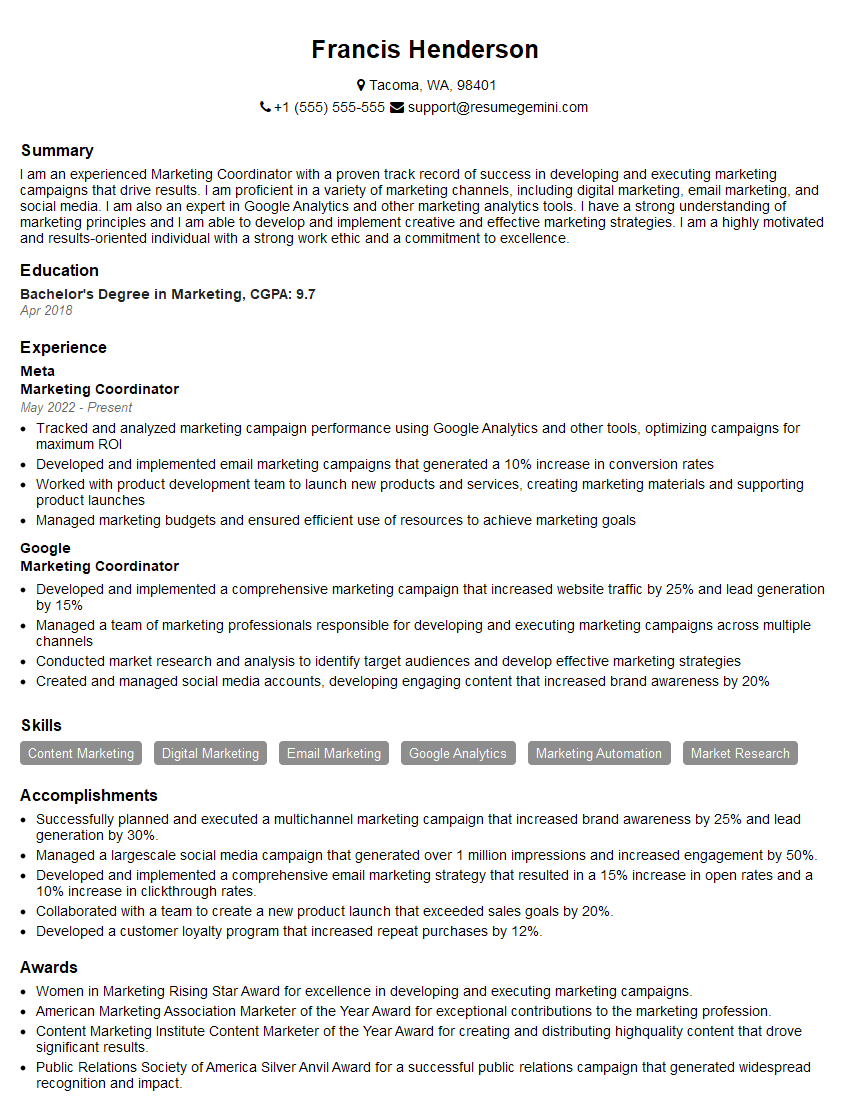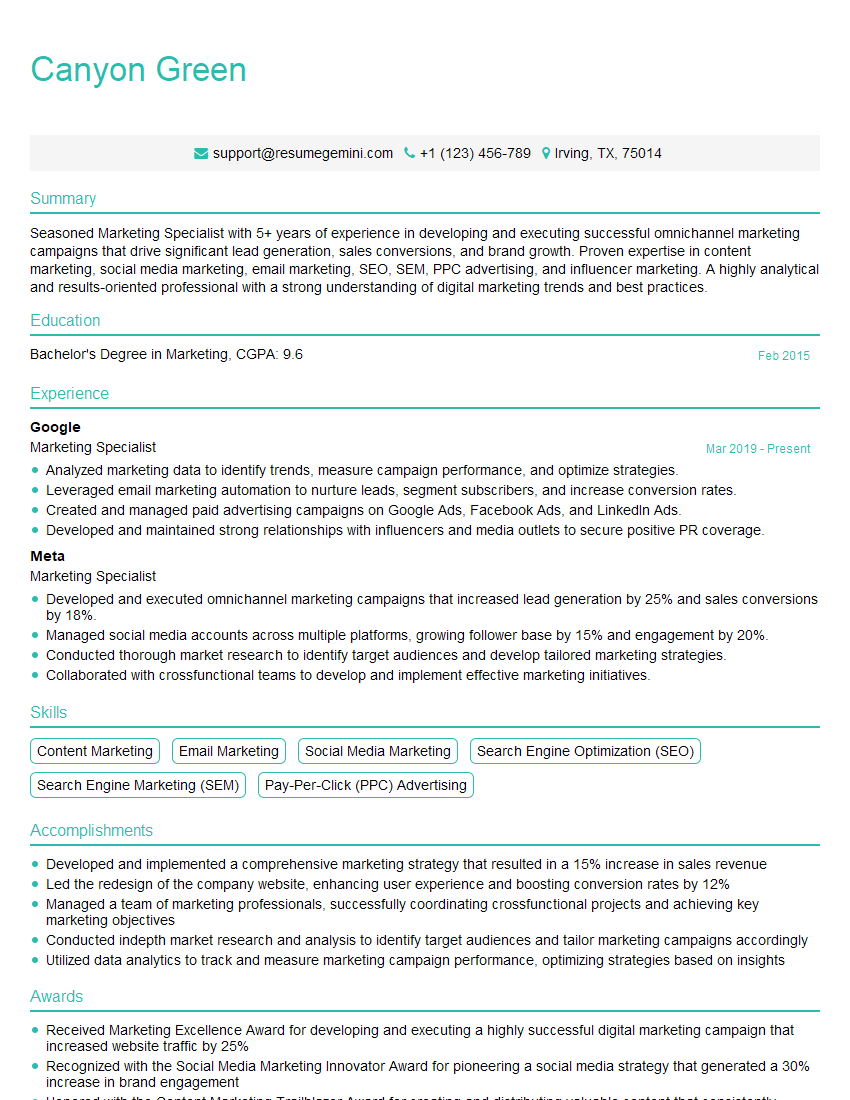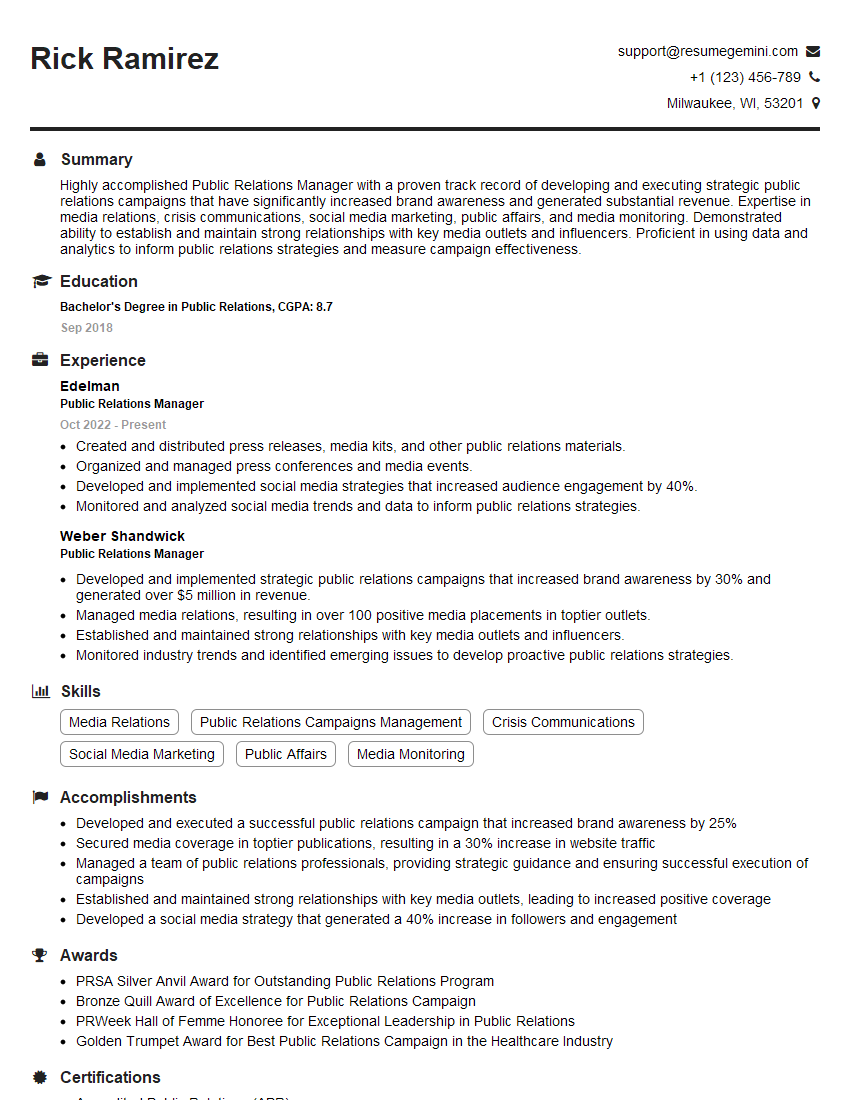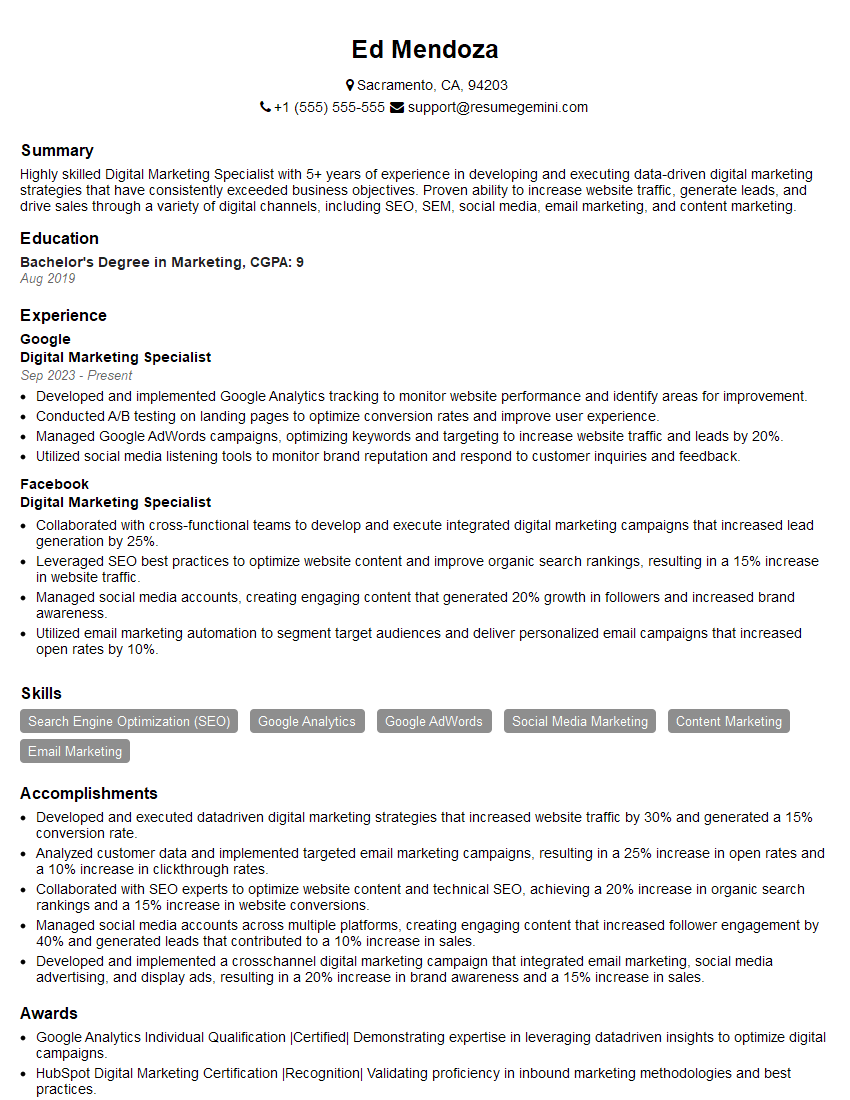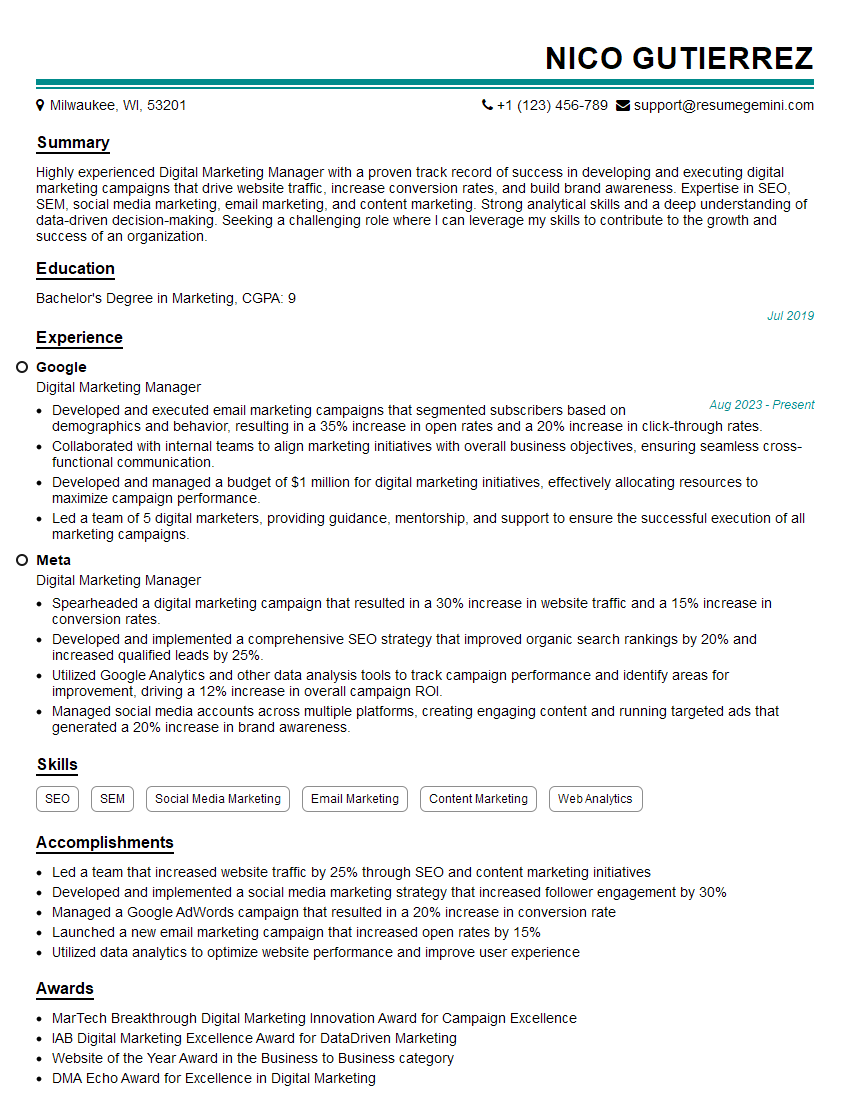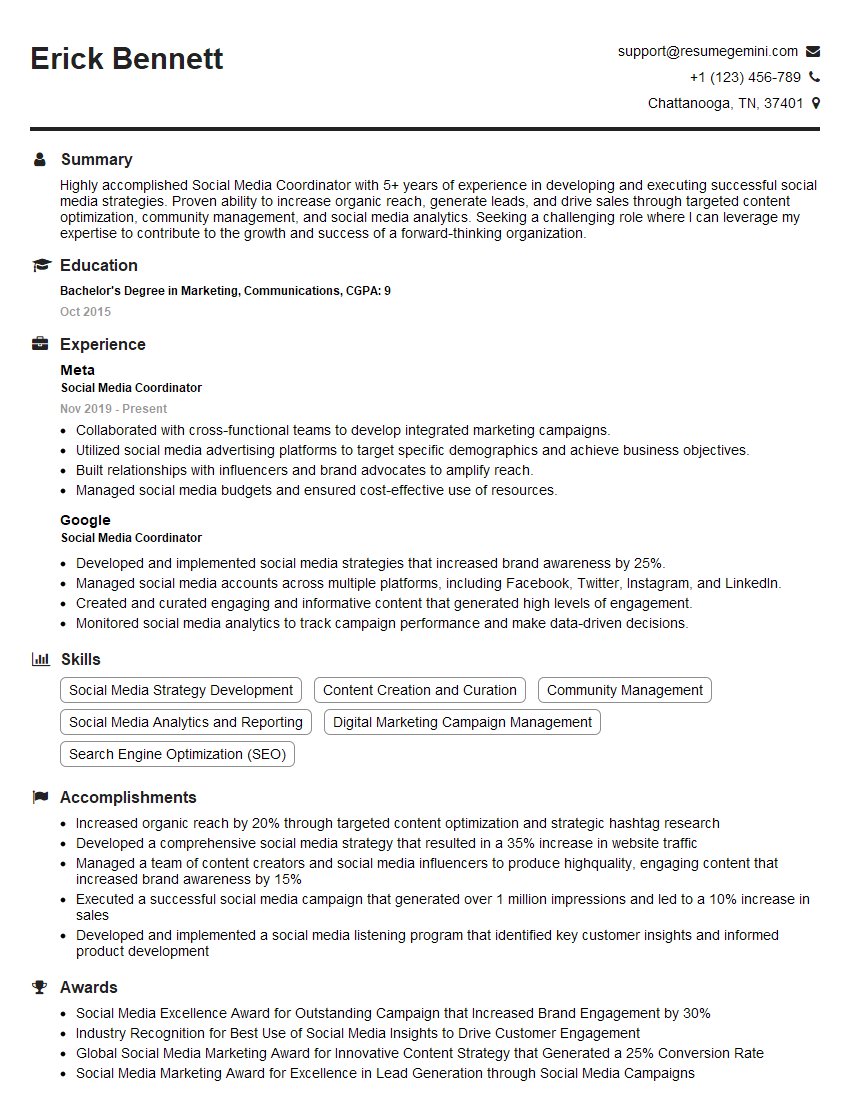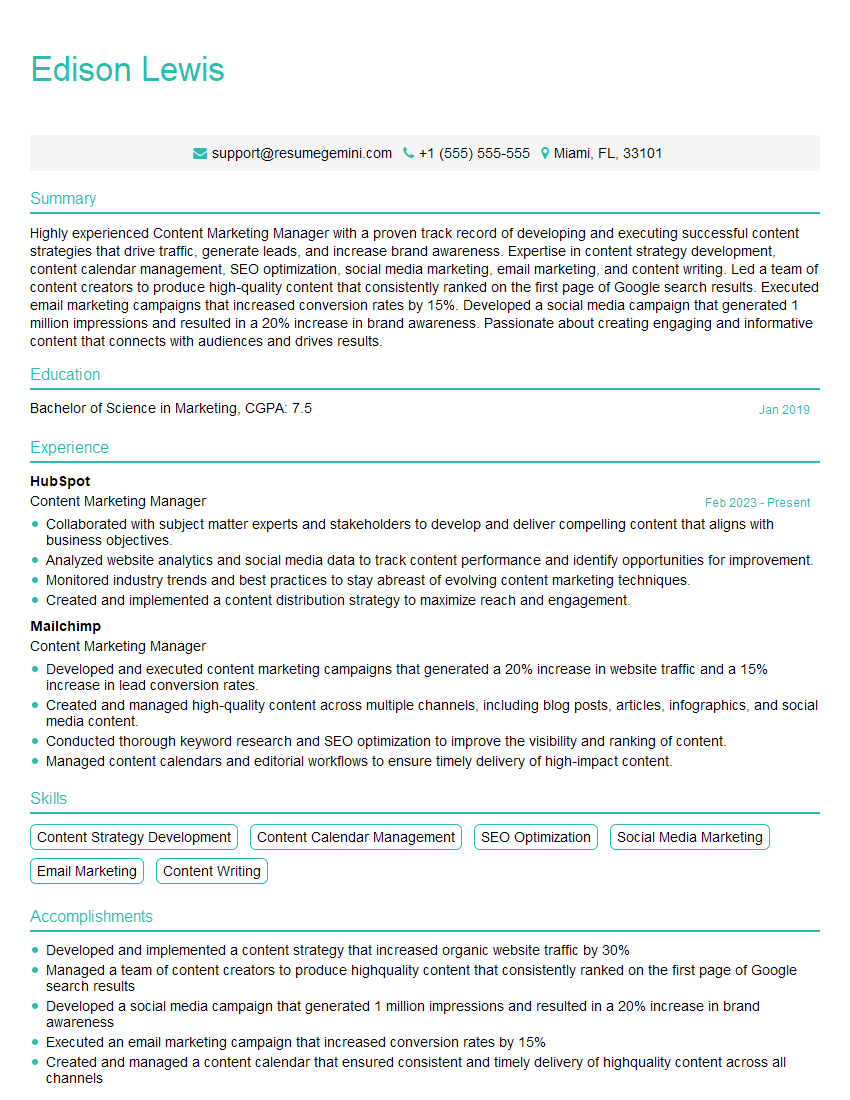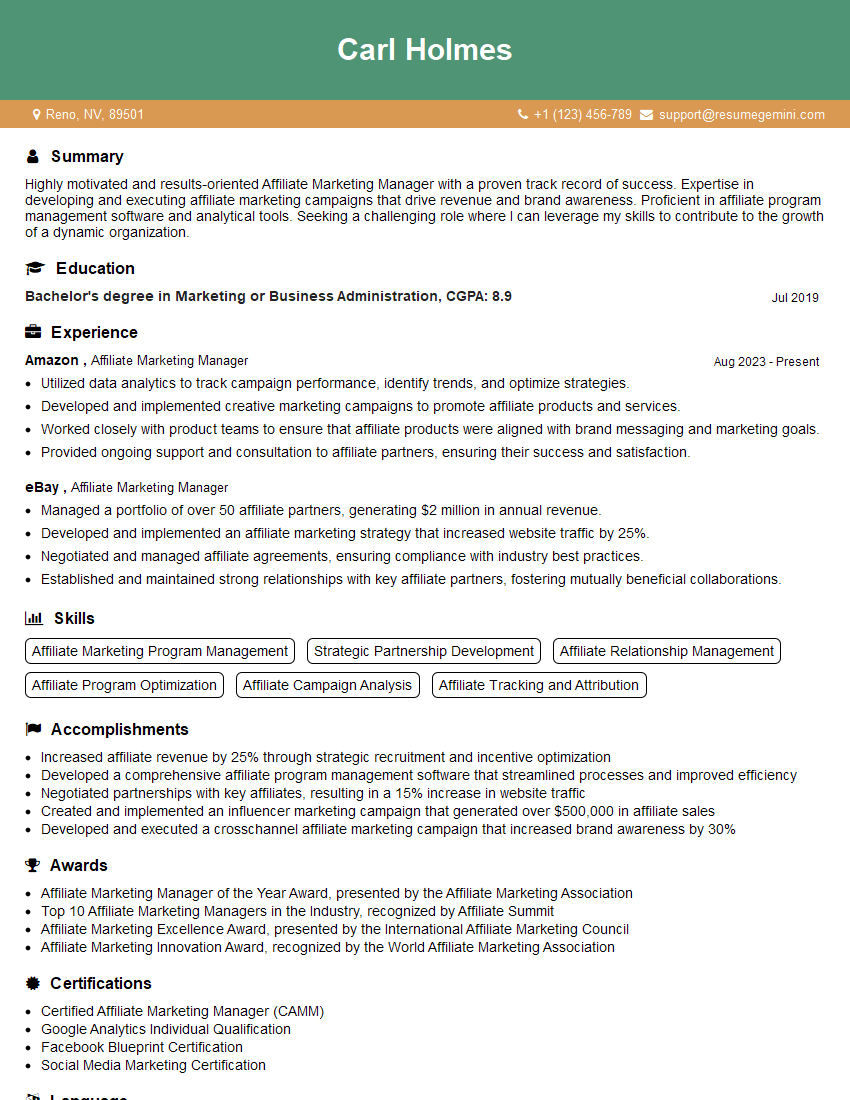Feeling uncertain about what to expect in your upcoming interview? We’ve got you covered! This blog highlights the most important Influencer Marketing and Partnerships interview questions and provides actionable advice to help you stand out as the ideal candidate. Let’s pave the way for your success.
Questions Asked in Influencer Marketing and Partnerships Interview
Q 1. Explain your experience in developing and executing influencer marketing campaigns.
Developing and executing influencer marketing campaigns involves a strategic approach that goes beyond simply selecting influencers. It’s about building a narrative that aligns with your brand’s values and resonates with the target audience. My experience encompasses every stage, from initial campaign conceptualization and strategy development to influencer selection, content creation, campaign execution, performance tracking, and post-campaign analysis. For example, in a recent campaign for a sustainable fashion brand, we focused on micro-influencers with a strong ethical fashion following. We developed a detailed content brief outlining the brand’s values, key messages, and desired aesthetic. The influencers created authentic content showcasing the clothing in their everyday lives, highlighting its sustainability. We also used a tiered approach, engaging a mix of nano, micro, and macro-influencers to reach a wider and more diverse audience.
This holistic approach ensured the campaign resonated with the target audience organically, leading to higher engagement rates and brand awareness. I always tailor my strategies to the specific client and campaign goals, whether it be increased website traffic, boosted sales, brand awareness, or lead generation. Each campaign is carefully planned to ensure maximum impact and ROI.
Q 2. How do you identify and select relevant influencers for a campaign?
Identifying and selecting the right influencers is crucial. It’s not just about follower count; it’s about audience alignment and authenticity. My process begins with a thorough understanding of the campaign’s objectives and target audience. We then define specific influencer criteria, including demographics, interests, engagement rates, audience authenticity (avoiding bought followers), and alignment with brand values. Tools like BuzzSumo, Upfluence, and Grin are valuable for identifying potential influencers. However, I always manually vet potential candidates, analyzing their content, audience engagement, and overall brand fit. We prioritize influencers who demonstrate genuine passion for the brand or product category. For instance, for a campaign focusing on eco-tourism, we’d seek influencers who actively promote sustainable travel and demonstrate a genuine interest in environmental conservation. This ensures authentic content and positive brand association.
After shortlisting potential candidates, we assess their past collaborations, analyzing the performance of similar campaigns to predict future success. This multi-faceted approach ensures the chosen influencers resonate with our target audience and are highly likely to drive the desired results for the campaign.
Q 3. Describe your process for measuring the success of an influencer marketing campaign.
Measuring the success of an influencer marketing campaign requires a multi-faceted approach, moving beyond simple vanity metrics like likes and comments. My process involves defining Key Performance Indicators (KPIs) aligned with the campaign goals before its launch. We use a mix of quantitative and qualitative data points. Quantitative metrics include website traffic (tracked via UTM parameters), sales conversions (using unique discount codes or affiliate links), social media engagement (likes, shares, comments, saves), brand mentions, and reach. Qualitative analysis focuses on audience sentiment, the overall brand narrative portrayed by the influencers, and the authenticity of the content. We conduct thorough sentiment analysis of comments and mentions to gauge the public’s perception of the campaign and the brand.
For example, if the goal is driving website traffic, we’d track clicks from the influencer’s posts using UTM parameters to measure the specific traffic generated. If the goal is sales, we use unique discount codes to directly attribute sales to the campaign. Post-campaign reports provide detailed analysis of performance against the pre-defined KPIs, providing insights for future campaigns.
Q 4. What key performance indicators (KPIs) do you track for influencer marketing campaigns?
The KPIs tracked for influencer marketing campaigns are highly dependent on the campaign objectives. However, some common KPIs I track include:
- Reach and Impressions: Total number of unique users exposed to the campaign.
- Engagement Rate: Likes, comments, shares, saves, and other interactions normalized by the number of followers.
- Website Traffic & Conversions: Number of clicks to the website from influencer posts and resulting conversions (sales, leads).
- Brand Mentions: Number of times the brand is mentioned across various platforms.
- Sentiment Analysis: Tracking the positive, negative, and neutral sentiment surrounding the brand from influencer posts and audience comments.
- Return on Investment (ROI): The net profit generated from the campaign relative to its cost.
The specific KPIs emphasized will vary based on client needs and campaign goals. For a brand focused on increasing sales, conversion rate and ROI would be paramount. For a brand focused on raising brand awareness, reach and impressions would take center stage.
Q 5. How do you manage influencer relationships and communications?
Managing influencer relationships is about building trust and fostering long-term partnerships. Communication is key. I maintain open and consistent communication with influencers throughout the entire campaign lifecycle. This includes clear briefings, regular check-ins, feedback sessions, and prompt payment. I utilize project management tools to centralize communication and streamline the process. Personalization is crucial; I strive to understand each influencer’s individual needs and preferences, tailoring our interactions accordingly. Building rapport is essential; I treat each influencer as a partner, not just a vendor. Regular feedback and appreciation go a long way in fostering strong relationships.
For example, after a successful campaign, I often send a personalized thank-you note, acknowledging their contributions and highlighting their positive impact. This approach helps to cultivate lasting relationships that benefit both the brand and the influencer.
Q 6. What strategies do you use to negotiate contracts with influencers?
Negotiating contracts with influencers requires a clear understanding of both parties’ needs and expectations. I begin by clearly outlining the campaign scope, deliverables, timelines, and payment terms. My approach is collaborative; I listen to the influencer’s concerns and suggestions, aiming for a mutually beneficial agreement. I present a comprehensive contract that addresses intellectual property rights, usage rights, content guidelines, payment schedules, and termination clauses. I ensure transparency in pricing, explaining the rationale behind our offered rates, which are often based on the influencer’s audience size, engagement rate, and relevance to the brand. I always aim for a win-win scenario; a satisfied influencer is more likely to deliver high-quality content and contribute to a successful campaign.
Fair and transparent negotiation helps build trust and long-term relationships. I believe in fostering a partnership mentality rather than viewing the influencer as merely a service provider.
Q 7. How do you ensure brand compliance and safety within influencer campaigns?
Ensuring brand compliance and safety within influencer campaigns is crucial. I establish clear guidelines in the contract, addressing topics such as disclosure requirements (FTC compliance), content approval processes, brand messaging consistency, and prohibited content (e.g., hate speech, discriminatory language). Before campaign launch, influencers receive detailed style guides and brand assets. We utilize a pre-approval process, reviewing all content created by the influencers before publication. This ensures brand consistency and avoids potential risks associated with inappropriate or misleading content. Regular monitoring of influencer posts during and after the campaign helps identify and address any compliance issues promptly. I often utilize social listening tools to proactively track brand mentions and identify potential problems before they escalate.
We treat compliance not merely as a box to tick, but as an integral part of ensuring campaign success and protecting the brand’s reputation. A strong focus on transparency and consistent communication significantly contributes to our risk mitigation strategies.
Q 8. How do you handle negative feedback or controversies involving an influencer?
Handling negative feedback or controversies involving an influencer requires a swift, transparent, and measured response. It’s crucial to prioritize damage control and protect the brand’s reputation. My approach involves these key steps:
- Immediate Assessment: First, we thoroughly analyze the nature and extent of the controversy. Is it a minor issue or a significant reputational risk? Who is involved, and what’s the sentiment online?
- Communication Strategy: We then develop a comprehensive communication strategy. This might involve issuing a public statement, engaging with concerned parties directly (through comments or private messages), or collaborating with the influencer on a response. Transparency is key; attempting to sweep things under the rug rarely works.
- Collaboration with the Influencer: Open communication with the influencer is paramount. We work together to understand the situation, determine responsibility, and agree on a unified response. This fosters trust and ensures a consistent message.
- Monitoring and Mitigation: We continuously monitor the situation across social media and other online platforms. We address further comments and concerns promptly and professionally, striving to turn the narrative in a positive direction. If necessary, we might consider removing problematic content or taking legal action.
- Post-Crisis Review: Once the immediate crisis has passed, we conduct a thorough post-mortem analysis. This helps us learn from the experience, refine our crisis management plan, and prevent similar issues in future campaigns.
For example, if an influencer is caught using fake followers or engaging in unethical behavior, we would immediately cease the campaign, assess the damage to our brand reputation, and issue a public statement emphasizing our commitment to ethical influencer marketing. We might also terminate our contract with the influencer.
Q 9. Explain your understanding of influencer marketing regulations and guidelines.
Influencer marketing regulations and guidelines are constantly evolving, varying by country and platform. My understanding encompasses several key areas:
- FTC Guidelines (US): In the US, the Federal Trade Commission (FTC) requires clear and conspicuous disclosures of any material connections between influencers and brands. This includes sponsored posts, affiliate links, and free products. Failure to disclose can result in significant penalties.
- Platform-Specific Policies: Each platform (Instagram, YouTube, TikTok, etc.) has its own community guidelines and advertising policies that influencers must adhere to. These guidelines often address issues such as prohibited content, misleading information, and authenticity.
- Data Privacy Regulations: Influencer marketing often involves collecting user data. It’s critical to comply with regulations such as GDPR (in Europe) and CCPA (in California) to ensure responsible data handling and user privacy.
- Copyright and Intellectual Property: Using copyrighted material without permission is a serious legal issue. We always ensure that all content created for campaigns respects copyright laws and intellectual property rights.
- Transparency and Authenticity: Even beyond legal requirements, ethical influencer marketing prioritizes transparency and authenticity. Influencers should genuinely believe in the product or service they’re promoting and disclose any potential bias.
Ignoring these regulations can lead to fines, reputational damage, and a loss of consumer trust. I always prioritize compliance and encourage a culture of ethical marketing within our campaigns.
Q 10. What are the different types of influencer marketing campaigns?
There’s a wide variety of influencer marketing campaigns, each tailored to specific goals and target audiences. Some common types include:
- Sponsored Posts: Influencers create content (photos, videos, stories, etc.) featuring a brand’s product or service. This is a classic and effective method.
- Affiliate Marketing: Influencers promote products using unique affiliate links. They earn a commission for each sale generated through their link.
- Giveaway Campaigns: Influencers host giveaways to increase brand awareness and engagement. This is particularly effective at boosting follower counts.
- Brand Ambassadorships: Long-term partnerships where influencers represent a brand consistently across various platforms. This builds stronger relationships and brand loyalty.
- User-Generated Content (UGC) Campaigns: Encouraging customers to create and share their own content related to the brand. This leverages authenticity and social proof.
- Live Streams/Webinars: Engaging with audiences in real-time, often featuring product demonstrations or Q&A sessions.
- Influencer Takeovers: Allowing an influencer to temporarily manage a brand’s social media accounts to interact directly with the audience.
The choice of campaign type depends on factors like budget, campaign goals, target audience, and brand identity. For instance, a small business might favor affiliate marketing due to its lower upfront cost, while a large corporation might opt for a long-term brand ambassadorship to build a stronger brand image.
Q 11. Describe your experience with various influencer marketing platforms and tools.
I have extensive experience using various influencer marketing platforms and tools. These include:
- Social Media Platforms: Instagram, YouTube, TikTok, Facebook, Twitter – I’m proficient in using the native features of each platform for campaign management, content scheduling, and analytics.
- Influencer Marketing Platforms: Tools like Upfluence, AspireIQ, and Grin help identify and manage influencers, track campaign performance, and facilitate communication.
- Social Listening Tools: Brand24, Talkwalker, and Mention allow us to monitor brand mentions and sentiment across social media, identifying potential crises or opportunities.
- Analytics Platforms: Google Analytics, along with platform-specific analytics dashboards, provide data on campaign performance and ROI.
I also utilize project management software such as Asana or Trello to organize campaigns and collaborate effectively with team members and influencers. Each platform offers unique capabilities, and I select the most appropriate tools based on the specific campaign requirements and budget. For instance, for a smaller campaign, I might focus on direct outreach through social media platforms, while a larger, more complex campaign might necessitate using a dedicated influencer marketing platform.
Q 12. How do you measure the ROI of an influencer marketing campaign?
Measuring the ROI of an influencer marketing campaign isn’t a simple task, but it’s crucial for demonstrating its value. My approach involves a multi-faceted strategy:
- Pre-Campaign Goals: Define clear, measurable objectives (e.g., increased website traffic, brand awareness, lead generation, sales).
- Trackable Metrics: Monitor key performance indicators (KPIs) throughout the campaign, including website clicks, social media engagement (likes, comments, shares), brand mentions, and sales conversions (using unique discount codes or affiliate links).
- Attribution Modeling: Understand which touchpoints contribute to conversions. This can be challenging but helps assign proper credit to the influencer campaign.
- Qualitative Data: Analyze brand sentiment, changes in audience demographics, and overall brand perception based on influencer content.
- Post-Campaign Analysis: Compare pre-campaign baselines with post-campaign results to assess the effectiveness of the campaign. Use both quantitative and qualitative data to provide a holistic view.
For example, if our goal is increased website traffic, we’ll track the number of clicks from the influencer’s content to our website. We can also assign a monetary value to each click or conversion to calculate a more precise ROI.
Q 13. What are some common challenges in influencer marketing, and how do you overcome them?
Influencer marketing presents several challenges:
- Finding the Right Influencers: Identifying influencers who align with the brand’s values, target audience, and campaign goals can be time-consuming and require careful research.
- Measuring ROI: Accurately attributing sales or other desired outcomes solely to influencer marketing can be difficult.
- Managing Influencer Relationships: Maintaining effective communication and collaboration with influencers is essential for successful campaigns.
- Authenticity and Transparency: Ensuring that influencers maintain authenticity and comply with disclosure requirements is crucial to build consumer trust.
- Fraudulent Activities: Dealing with fake followers, engagement, or reviews is a constant concern.
To overcome these challenges, I leverage robust research methods to identify suitable influencers, utilize advanced analytics tools to track ROI, prioritize transparent communication, and implement thorough due diligence processes to identify fraudulent activities. Proactive planning, careful selection, consistent communication, and thorough monitoring are key to mitigating risks and achieving success.
Q 14. How do you integrate influencer marketing with other marketing channels?
Integrating influencer marketing with other marketing channels is crucial for maximizing its effectiveness. This synergistic approach involves:
- Content Amplification: Using influencer content across other channels (e.g., website, email marketing, paid advertising) to reach a wider audience.
- Cross-Promotion: Encouraging influencers to promote other marketing initiatives (e.g., contests, events, webinars) and vice versa.
- Consistent Messaging: Maintaining a cohesive brand message across all channels, including influencer content. This creates a unified and impactful brand experience.
- Data Integration: Combining data from influencer campaigns with data from other channels to gain a holistic view of campaign performance.
- Targeted Advertising: Using influencer insights to inform paid advertising campaigns, improving targeting and messaging.
For instance, an influencer’s compelling video review could be featured on the brand’s website and shared through email marketing campaigns. This integrated approach ensures greater visibility and reinforces the brand message across multiple touchpoints.
Q 15. How do you build and maintain strong relationships with influencers?
Building and maintaining strong influencer relationships is the cornerstone of successful influencer marketing. It’s not just about transactional partnerships; it’s about cultivating genuine connections based on mutual respect and shared goals.
- Personalized Communication: I avoid generic outreach. I research each influencer thoroughly, understanding their audience, content style, and brand values. My initial communication is always personalized, highlighting what resonates between their brand and my client’s.
- Transparency and Honesty: Open communication is key. I clearly outline campaign expectations, deliverables, and timelines from the start. I also am upfront about any potential challenges or limitations.
- Value-Driven Partnerships: I focus on creating mutually beneficial collaborations. This might involve offering exclusive access, early product samples, or creative freedom to ensure the influencer feels valued and invested in the success of the campaign.
- Ongoing Engagement: A successful relationship doesn’t end after a campaign. I maintain regular communication, share campaign results, and seek feedback. This shows I value their contribution and am committed to a long-term partnership.
- Relationship Building beyond Campaigns: I often attend industry events and connect with influencers on a personal level. This builds rapport and fosters a sense of community.
For example, I once worked with a micro-influencer who specialized in sustainable living. Instead of just sending a product, I invited her to a behind-the-scenes tour of our eco-friendly factory. This fostered a genuine connection and resulted in more authentic and impactful content.
Career Expert Tips:
- Ace those interviews! Prepare effectively by reviewing the Top 50 Most Common Interview Questions on ResumeGemini.
- Navigate your job search with confidence! Explore a wide range of Career Tips on ResumeGemini. Learn about common challenges and recommendations to overcome them.
- Craft the perfect resume! Master the Art of Resume Writing with ResumeGemini’s guide. Showcase your unique qualifications and achievements effectively.
- Don’t miss out on holiday savings! Build your dream resume with ResumeGemini’s ATS optimized templates.
Q 16. Describe your experience with influencer marketing budget management.
Influencer marketing budget management requires a strategic approach. It’s not just about allocating funds; it’s about maximizing ROI.
- Defining Clear Objectives: Before allocating any budget, I define specific, measurable, achievable, relevant, and time-bound (SMART) goals. This ensures that every dollar spent contributes to achieving the campaign objectives.
- Influencer Tiering: I carefully consider the cost-effectiveness of different influencer tiers (macro, micro, nano). While macro-influencers have broader reach, micro and nano influencers often offer higher engagement rates and a stronger sense of community. I balance reach and engagement based on campaign goals and budget.
- Negotiating Rates: I possess strong negotiation skills to secure favorable rates with influencers while maintaining mutually beneficial arrangements. This includes exploring options like performance-based compensation (e.g., pay-per-click or commission) to align incentives.
- Tracking and Reporting: I meticulously track all expenses, including influencer fees, platform advertising costs, content creation fees, and any other relevant expenses. Regular reporting allows for adjustments and optimization during the campaign.
- Contingency Planning: Unforeseen issues can arise. A well-managed budget includes a contingency fund to address unforeseen circumstances without impacting the campaign’s success.
For instance, for a recent campaign, I used a tiered approach, allocating a larger portion to micro-influencers for targeted engagement and a smaller amount to a macro-influencer for wider reach. This strategy maximized ROI within the allocated budget.
Q 17. How do you identify potential conflicts of interest in influencer partnerships?
Identifying potential conflicts of interest is crucial for maintaining transparency and ethical practices in influencer marketing. Conflicts can damage an influencer’s credibility and negatively impact the brand.
- Disclosure Policy Review: I thoroughly review an influencer’s disclosure policy to ensure they adhere to FTC guidelines and platform regulations regarding sponsored content. This ensures transparency with the influencer’s audience.
- Competitor Analysis: I investigate if the influencer has worked with direct competitors recently, as this could dilute the impact of the campaign or create a conflict.
- Brand Alignment Assessment: I assess whether the influencer’s personal brand values, past endorsements, and overall image align with the client’s brand. Incongruence can lead to negative perceptions.
- Audience Alignment Review: I examine the influencer’s audience demographics and interests to ensure they align with the target audience for the campaign. A mismatch will result in wasted resources.
- Contractual Clauses: I incorporate clear clauses in the influencer agreement that address potential conflicts and outline the procedures for resolving any issues.
For example, if an influencer regularly promotes a competitor’s product, it would be a conflict of interest to collaborate with a direct competitor without careful consideration and clear disclosure.
Q 18. What is your experience with influencer marketing analytics and reporting?
Influencer marketing analytics and reporting are essential for measuring campaign success and informing future strategies. It’s not enough to just post and hope for the best; data-driven decisions are crucial.
- Key Performance Indicators (KPIs): I define relevant KPIs upfront, including reach, engagement (likes, comments, shares), website clicks, conversions (sales, sign-ups), brand mentions, and sentiment analysis. The KPIs will depend on the campaign objectives.
- Platform-Specific Analytics: I utilize platform-specific analytics tools (e.g., Instagram Insights, YouTube Analytics) to track performance across different channels. This provides a comprehensive view of campaign impact.
- Custom Tracking Links and Codes: I use unique URLs, UTM parameters, and promo codes to track website traffic and conversions driven by influencer marketing campaigns. This allows me to isolate the impact of specific influencers.
- Sentiment Analysis Tools: I leverage sentiment analysis tools to gauge audience reaction and identify any negative feedback or potential PR issues.
- Reporting and Visualization: I create clear and concise reports, using data visualization techniques (charts, graphs) to present key findings effectively. This allows stakeholders to easily understand campaign performance.
For example, a recent campaign showed that micro-influencers generated a higher conversion rate than macro-influencers. This data informed our budget allocation for future campaigns.
Q 19. How do you choose the appropriate influencer type (macro, micro, nano) for a campaign?
Choosing the right influencer type (macro, micro, or nano) depends on the campaign’s goals and target audience. Each type offers distinct advantages.
- Macro-influencers (1M+ followers): Best for broad reach and brand awareness. Their large audiences can expose your brand to a massive potential customer base. However, engagement rates are often lower, and costs can be significantly higher.
- Micro-influencers (10k-1M followers): Often provide higher engagement rates and a stronger sense of community. They can be more cost-effective than macro-influencers and are better suited for targeted campaigns.
- Nano-influencers (under 10k followers): Offer the highest engagement rates and often have highly niche and engaged audiences. They can be particularly effective for building trust and authenticity, but their reach is limited.
Example: For a campaign aimed at building brand awareness among a broad demographic, a macro-influencer might be suitable. However, for a campaign targeting a niche market with a focus on building trust and authenticity, nano or micro-influencers would be a better choice.
The decision-making process involves careful consideration of budget, campaign goals, and target audience characteristics. It’s not uncommon to use a mix of influencer tiers for a more comprehensive approach.
Q 20. Describe your process for creating influencer campaign briefs.
A well-structured influencer campaign brief is crucial for clear communication and successful collaboration. It acts as a roadmap for the influencer.
- Campaign Goals and Objectives: Clearly defined SMART goals—what needs to be achieved.
- Target Audience: Detailed description of the ideal customer—demographics, interests, behaviors.
- Brand Overview: Information about the brand, its mission, values, and unique selling propositions.
- Product/Service Information: Comprehensive details about the product or service being promoted—key features, benefits, and usage instructions.
- Creative Guidelines: Style guide, tone of voice, content themes, and examples of successful campaigns.
- Content Pillars: Specific themes or topics that should be addressed in the content.
- Call to Action (CTA): What the influencer should encourage their audience to do—visit website, make a purchase, sign up for newsletter.
- Timeline and Deliverables: Key dates, deadlines, and expected content outputs.
- Compensation and Payment Terms: Clear outline of the payment structure and payment schedule.
- Reporting and Analytics: Details on how campaign performance will be tracked and reported.
A well-crafted brief minimizes misunderstandings and ensures everyone is on the same page, fostering a successful partnership. I usually include examples of successful past campaigns to inspire the influencer’s creative direction.
Q 21. How do you track and analyze influencer campaign data to improve future campaigns?
Tracking and analyzing influencer campaign data is crucial for continuous improvement. This iterative process helps optimize future strategies.
- Data Collection: I gather data from various sources including platform analytics, custom tracking links, and influencer reports.
- KPI Analysis: I analyze the performance against predefined KPIs, identifying areas of strength and weakness.
- Qualitative Analysis: I review influencer content and audience comments to understand engagement quality and sentiment.
- Comparative Analysis: I compare the performance of different influencers and campaigns to identify best practices and areas for optimization.
- A/B Testing: Where appropriate, I conduct A/B tests to compare different creative approaches or messaging strategies.
- Feedback Integration: I gather feedback from influencers and internal stakeholders to identify areas for improvement.
- Reporting and Refinement: I create comprehensive reports summarizing findings and propose improvements for future campaigns.
For example, if a campaign underperforms, I might analyze the data to identify the reasons. This could be due to poor content quality, targeting issues, or unsuitable influencer selection. I then use these insights to refine future strategies and improve campaign performance.
Q 22. What are your thoughts on the future of influencer marketing?
The future of influencer marketing is incredibly dynamic and exciting. We’re moving beyond simple sponsored posts towards more authentic and integrated partnerships. I foresee a significant rise in:
- Micro and nano-influencers: Brands will increasingly leverage smaller influencers with highly engaged niche audiences for greater authenticity and ROI.
- Data-driven strategies: Sophisticated analytics and tracking will become even more crucial to measure campaign effectiveness and optimize influencer selection.
- Livestreaming and interactive content: Real-time engagement through platforms like Instagram Live and TikTok will offer more immediate and impactful brand experiences.
- AI-powered tools: Artificial intelligence will play a larger role in identifying potential influencers, analyzing campaign performance, and even automating aspects of campaign management.
- Increased focus on transparency and disclosure: Regulations and consumer demand for transparency will continue to drive clearer communication about sponsored content.
- The Metaverse and Web3: Influencer marketing will expand into virtual worlds and utilize technologies like NFTs to create unique experiences and brand interactions.
Essentially, the future is about building genuine relationships, leveraging data intelligently, and embracing innovative technologies to create meaningful connections between brands and their target audiences.
Q 23. How do you ensure authenticity and transparency in influencer marketing campaigns?
Authenticity and transparency are paramount in influencer marketing. Without them, campaigns risk damaging brand reputation and eroding consumer trust. Here’s how I ensure both:
- Clear Disclosure: I always insist on clear and prominent disclosure of sponsored content. This includes using hashtags like #ad, #sponsored, or clearly stating the partnership within the content itself.
- Influencer Selection: I meticulously vet influencers, looking for those whose values and audience align with the brand’s. I assess their engagement rate, audience demographics, and past collaborations to identify genuine brand advocates.
- Creative Brief Guidance: I provide detailed creative briefs to influencers, emphasizing authenticity and the importance of reflecting their genuine opinions and experiences. Forced enthusiasm never works.
- Content Review: While respecting the influencer’s creative freedom, I review all content before publication to ensure compliance with disclosure guidelines and brand messaging.
- Relationship Building: I prioritize long-term relationships with influencers. This fosters trust and encourages authentic endorsements, as opposed to one-off transactional partnerships.
- Transparency with Consumers: If there are any changes or delays to a campaign, we proactively inform consumers and maintain open communication.
For example, a recent campaign I managed involved partnering with a sustainable fashion brand. We carefully selected influencers known for their commitment to ethical fashion. Their genuine passion shone through in their posts, resonating deeply with their followers.
Q 24. Explain your understanding of different influencer marketing campaign models (e.g., gifting, paid partnerships).
Several influencer marketing campaign models exist, each with its own advantages and disadvantages:
- Gifting: Involves sending products to influencers for review and potential promotion. This can be a low-cost entry point but lacks control over the content and results. Success depends heavily on the influencer’s genuine interest and engagement with the product.
- Paid Partnerships: Influencers are paid a fee for creating and publishing sponsored content. This provides greater control over messaging and deliverables, ensuring the brand’s voice is accurately represented. However, it requires a higher budget.
- Affiliate Marketing: Influencers earn a commission for each sale generated through their unique referral links or codes. This model is performance-based, aligning incentives between the brand and influencer. It’s crucial to have robust tracking mechanisms.
- Contests and Giveaways: These generate excitement and amplify brand reach by leveraging the influencer’s audience to increase engagement and participation.
- Brand Ambassadorships: Long-term partnerships with influencers who deeply align with the brand’s values. This builds stronger brand loyalty and advocacy over time. These are usually higher-value contracts.
Choosing the right model depends on the brand’s budget, marketing objectives, and desired level of control.
Q 25. What is your experience with using influencer marketing for brand building versus direct sales?
My experience demonstrates that influencer marketing effectively serves both brand building and direct sales, though the strategies differ:
- Brand Building: This focuses on increasing brand awareness, enhancing brand image, and fostering emotional connections with the target audience. We use influencers with strong brand alignment to create engaging content that tells the brand story. Metrics like reach, engagement, and sentiment are key.
- Direct Sales: This prioritizes driving immediate sales through compelling calls to action, discount codes, and shoppable posts. Influencers with proven sales conversion rates are crucial here. Metrics like click-through rates, conversion rates, and revenue generated are paramount.
For instance, a recent campaign for a new skincare line focused on brand building initially. We partnered with beauty influencers to showcase the product’s benefits and the brand’s philosophy. Following this, we launched a direct sales-focused campaign with a different set of influencers, promoting a limited-time offer and providing unique discount codes.
Q 26. How do you handle influencer performance that falls short of expectations?
When influencer performance falls short, it requires a proactive and professional approach:
- Analyze the Results: Carefully review the campaign’s performance data, identifying specific areas where expectations weren’t met. Was it reach, engagement, or conversion rates?
- Communicate with the Influencer: Have an open and honest conversation with the influencer to understand their perspective and any challenges encountered.
- Identify Root Causes: Determine the reasons for underperformance. Was it poor content quality, targeting issues, or unforeseen external factors?
- Negotiate a Resolution: Depending on the circumstances and contract terms, consider options like renegotiating the fee, extending the campaign duration, or requesting additional content.
- Learn and Adapt: Thoroughly analyze the campaign to extract valuable lessons. Refine future strategies based on the findings to improve performance.
For example, if engagement is low, we might examine the content’s quality, targeting, and timing. We might then work with the influencer to create more engaging content or explore different posting schedules.
Q 27. How would you approach developing an influencer marketing strategy for a new product launch?
Developing an influencer marketing strategy for a new product launch requires a well-defined plan:
- Define Objectives and KPIs: Clearly state what you want to achieve (e.g., brand awareness, website traffic, sales). Set measurable KPIs to track success.
- Identify Target Audience: Understand the demographics, interests, and online behavior of your ideal customer.
- Influencer Selection: Identify influencers who align with your brand, target audience, and campaign objectives. Consider factors like audience size, engagement rate, niche relevance, and authenticity.
- Develop a Creative Brief: Provide influencers with clear guidelines on messaging, content style, and desired outcomes. Include examples of successful campaigns.
- Content Calendar and Timeline: Create a schedule for content creation and publication, ensuring it aligns with the product launch date.
- Campaign Tracking and Measurement: Implement tracking mechanisms to monitor campaign performance against KPIs. Use analytics dashboards to assess results and optimize the strategy mid-campaign.
- Post-Launch Analysis: Evaluate the campaign’s overall success against the set objectives and KPIs. Identify what worked well and what could be improved for future campaigns.
Remember, a successful launch requires a cohesive strategy that blends pre-launch buzz with post-launch momentum, leveraging influencers at different stages of the product lifecycle.
Q 28. Describe your experience with using influencer marketing to target specific demographics.
Targeting specific demographics through influencer marketing involves careful selection and strategic planning:
- Audience Research: Begin by thoroughly researching your target demographic’s online behavior, preferred platforms, and influential figures within their communities.
- Influencer Selection: Select influencers whose audience closely matches your target demographic in terms of age, location, interests, and lifestyle. Examine their audience demographics carefully using available analytics tools.
- Content Customization: Tailor the creative brief to ensure the content resonates with the specific demographic. The messaging, tone, and visual style should align with the audience’s preferences.
- Platform Selection: Choose the appropriate social media platforms where your target demographic is most active. For example, TikTok might be ideal for a younger audience, while LinkedIn might be better for a professional demographic.
- Campaign Tracking and Analysis: Monitor campaign performance across different demographics to identify which strategies are most effective. This data informs future targeting decisions and campaign optimization.
For example, I recently worked with a brand targeting Gen Z. We used TikTok influencers known for their creative and authentic content, emphasizing user-generated content and interactive challenges. This resulted in high levels of engagement and brand awareness within the target demographic.
Key Topics to Learn for Influencer Marketing and Partnerships Interview
- Understanding Influencer Landscape: Identifying key influencer platforms (Instagram, TikTok, YouTube, Twitch etc.), understanding different influencer tiers (Mega, Macro, Micro, Nano), and analyzing their audience demographics and engagement rates.
- Campaign Strategy & Planning: Developing targeted influencer marketing campaigns aligned with brand objectives, selecting suitable influencers based on campaign goals and audience alignment, setting clear KPIs and measuring campaign success.
- Contract Negotiation & Management: Understanding influencer contracts, negotiating rates and deliverables, managing influencer relationships, and ensuring compliance with FTC guidelines for disclosure and transparency.
- Content Creation & Collaboration: Working with influencers to create engaging and authentic content, providing creative briefs and guidelines, overseeing the content approval process, and ensuring brand consistency.
- Budget Allocation & ROI Measurement: Determining appropriate budget allocation for influencer marketing campaigns, tracking key performance indicators (KPIs) like reach, engagement, and conversions, and demonstrating return on investment (ROI).
- Crisis Management & Reputation Handling: Developing strategies to mitigate potential risks and address negative feedback or controversies involving influencers, protecting brand reputation during unexpected events.
- Data Analysis & Reporting: Utilizing data analytics tools to track campaign performance, generating insightful reports to demonstrate campaign effectiveness and inform future strategies.
- Legal and Ethical Considerations: Staying informed about FTC regulations concerning influencer marketing disclosures, maintaining ethical practices in influencer selection and campaign execution.
Next Steps
Mastering Influencer Marketing and Partnerships opens doors to exciting and rewarding careers in a dynamic industry. To significantly increase your job prospects, crafting an ATS-friendly resume is crucial. A well-structured resume highlights your skills and experience effectively, making you stand out to recruiters and applicant tracking systems. We strongly encourage you to use ResumeGemini, a trusted resource for building professional resumes. ResumeGemini provides you with the tools and support to create a compelling document that showcases your unique strengths. Examples of resumes tailored to Influencer Marketing and Partnerships are available to help guide your resume creation process.
Explore more articles
Users Rating of Our Blogs
Share Your Experience
We value your feedback! Please rate our content and share your thoughts (optional).
What Readers Say About Our Blog
Interesting Article, I liked the depth of knowledge you’ve shared.
Helpful, thanks for sharing.
Hi, I represent a social media marketing agency and liked your blog
Hi, I represent an SEO company that specialises in getting you AI citations and higher rankings on Google. I’d like to offer you a 100% free SEO audit for your website. Would you be interested?

